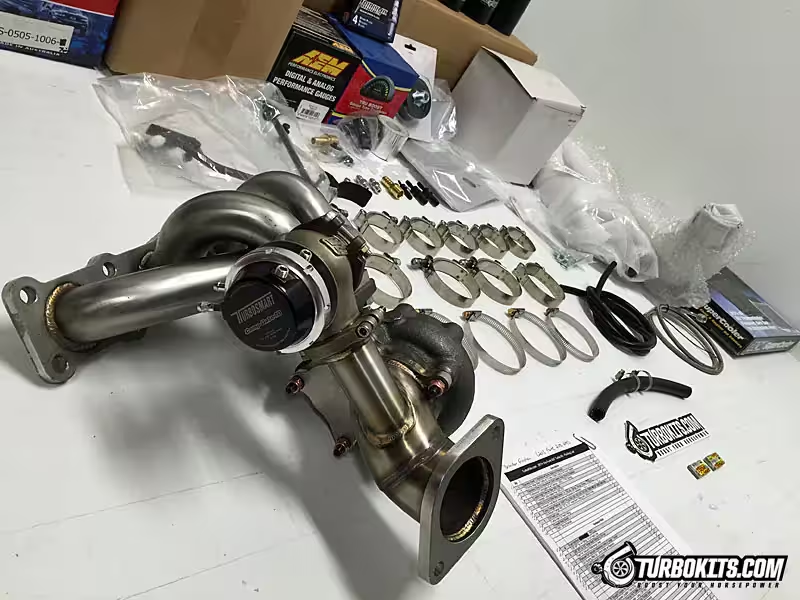
“Turbo Kit”… When you think of that package, what comes to mind? Sure, you’re likely thinking of a Turbocharger first, and maybe a blow off valve second- everyone wants a BOV, but when you consider the amount of time involved in configuring the whole bolt on package, the volume of hours is staggering! Pre-Production R&D is critical to building a quality, efficient kit and crew at TurboKits.com knows this! It isn’t out of the ordinary for them to spend a year in testing, tuning, tweaking, and improving a turbo system before releasing it to market. Ensuring the turbo is the correct size, the wastegate regulates boost properly, and the blow off valve sings that perfect tune, is part of the process. Although converting a naturally aspirated vehicle to forced induction may seem simple with a kit from TurboKits.com, it IS that way because the package is application specific. Your intercooler piping will be mandrel bent to fit your specific vehicle, the turbo exhaust manifold is designed for bolt on fitment, and the intercooler will tuck perfectly behind your stock bumper cover. Vehicle specific oil feed and drain lines necessary for turbo lubrication are included as well as the hardware and instructions. Is Technical support important to you? Tech guidance comes complimentary with every turbo kit purchase!

If your plan is to convert a naturally aspirated vehicle to turbo, most intercooled kits will be set to run around the 8 PSI level. At that pressure, a HP gain of roughly 60-70% over stock can be achieved with proper tuning. And YES, tuning is the key component when adding a turbocharger to your vehicle. In a naturally aspirated form, the ideal stoichiometric mixture for a gasoline engine is roughly 14.7:1 or for every one gram of fuel, 14.7 grams of air is consumed. After a turbo has been installed, the target air to fuel ratio changes to 11.1:1. Fuel is used as an aid to cool the cylinders and reduce the chances of combustion chamber detonation. Take the time to scroll through the complete kits at TurboKits.com, and you’ll likely note an electronic tuning solution is offered. These “controllers”, whether they are a piggy-back style- work in conjunction with the vehicle’s original computer, and OEM vehicle ECU recalibration, or a full stand-alone option, will need to be installed along with the turbo to achieve the desired air/fuel ratio and to control ignition timing. Timing and fuel delivery control are commonly adjusted based off information gathered by a MAP (Manifold Absolute Pressure) sensor. As the sensor “sees” pressure increasing, or “boost”, the electronic tuning device signals the injectors to flow more fuel and adjust timing based off the amount of pressure gain in the system, thus, maintaining that target 11:1 Air/fuel ratio under boost!

In addition to the electronic tuning device, another critical component of the turbo system is the intercooler. Maintaining a cooler air charge will provide a denser air charge, improving power output along with lowering the likelihood of combustion chamber detonation. The quality intercoolers provided with most of our kits are vehicle specific, so mounting tabs are installed, the proper couplers and clamps are utilized, and the correct inlet and outlet locations are chosen for ease of fitment and pipe routing. Compressing the induction air and the friction caused by the air passing through the charge piping, increases engine intake tempers. Amazingly enough, even on very hot days, a well-designed intercooler system can lower engine intake temp close to ambient air, even under hard boost pulls!

Once you’ve gotten your vehicle up and running turbo, fair warning, boost is addicting! Your craving for more power may overwhelm you and soon, you’ll be back on the phone with the team at TurboKits.com. More PSI, you say? Adding a boost controller, larger intercooler, bigger fuel system, water methanol injection, and even upgrading engine components to support that higher boost goal will likely be on your shopping list. While most kits come with a high quality journal bearing turbo, upgrading to a billet wheel, ball bearing configuration will ensure you have the latest and greatest in turbo technology! More power per pound of boost is the goal and the modern aero wheel designs provide faster throttle response and spool time. Internally and externally wastegated turbos are both available with the latest in materials and construction.

Whether you require added HP and TQ for towing, want to improve your track times, or see an increase in Miles per Gallon, log onto www.TurboKits.com for best in the business sales, tech, and product support and advice.



